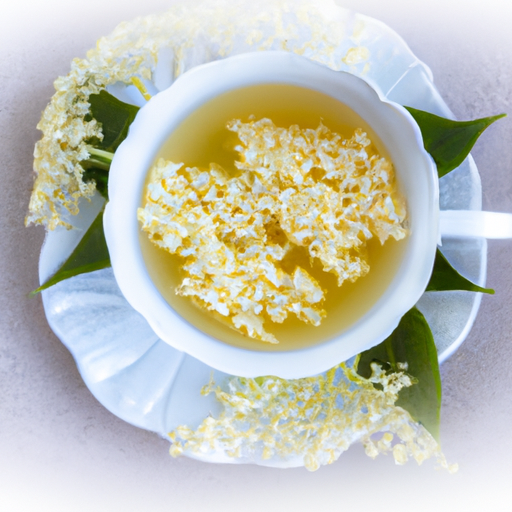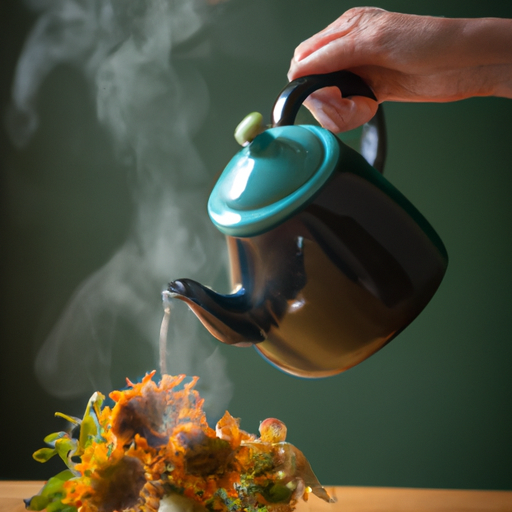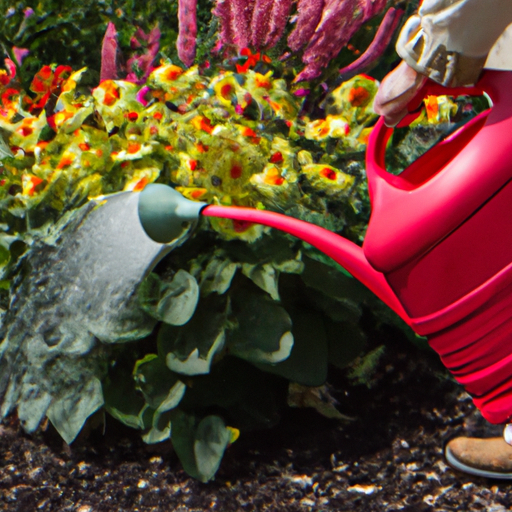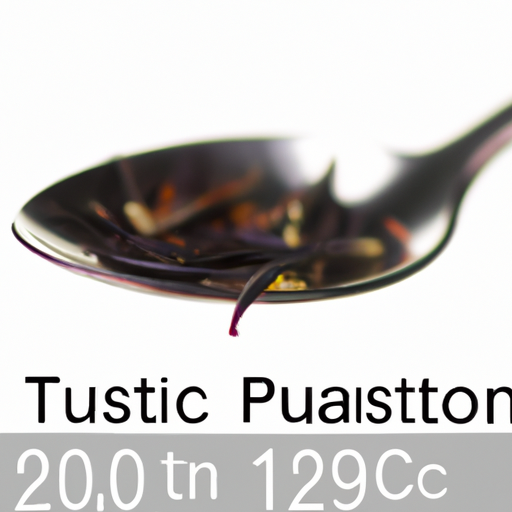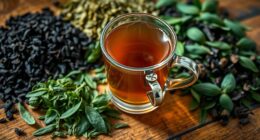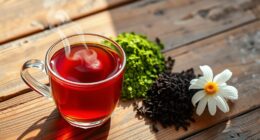As an avid tea enthusiast, I have always been captivated by the rich flavors and therapeutic benefits that different herbs and flowers can bring to a cup of tea.
Recently, I stumbled upon a fascinating theory that intrigued me to delve deeper into the world of herbal infusions. It is believed that the passion flower, scientifically known as Passiflora incarnata, possesses remarkable calming properties and can promote a restful night’s sleep.
Eager to explore this theory further, I embarked on a journey to learn how to gather and dry passion flowers for tea. In this article, I will share my knowledge and experience, guiding you through the process of identifying and locating passion flower plants, choosing the optimal time for harvest, preparing the flowers for drying, storing them properly, and ultimately, brewing a delightful cup of passion flower tea.
So let’s dive in and uncover the secrets of this enchanting flower and its delightful infusion.
Key Takeaways
- Passion flowers should be harvested when fully open and at their peak freshness, preferably in the morning before the heat of the day sets in.
- Handle passion flowers with care to avoid bruising or wilting, and remove any damaged or wilted petals before drying.
- Passion flowers can be air dried by tying the stems of a bunch together and hanging them upside down in a well-ventilated area, or they can be dried in a dehydrator or oven.
- Store dried passion flowers in airtight containers in a cool, dark place, and label containers with the drying date and herb name for identification and rotation.
Identifying and Locating Passion Flower Plants
If you’re looking to make your own passion flower tea, it’s essential to know how to identify and locate these beautiful plants in the wild. Passion flower, or Passiflora, is a genus of flowering plants that encompasses over 500 species. However, the most commonly used species for tea is Passiflora incarnata.
Growing passion flower at home is a viable option for those who want a readily available supply. These plants thrive in warm climates and prefer full sun or partial shade. They require well-draining soil and benefit from regular watering. Passion flower vines are known for their vigorous growth, so providing a trellis or structure for support is essential.
Understanding the growth requirements of passion flower is crucial to successfully cultivating these plants. They can be grown from seeds or propagated through cuttings. When planting, ensure you give them enough space to spread and grow. Regular pruning is necessary to keep the plants in control and promote healthy growth.
Now that you know how to grow passion flower, let’s move on to choosing the right time to harvest.
[Transition sentence]Choosing the Right Time to Harvest
When you’re ready to select the perfect moment for harvesting, keep an eye out for the ideal time to pluck those vibrant blossoms for your delightful cup of herbal infusion.
Choosing the right time to harvest passion flowers is crucial to ensure optimal flavor and potency in your tea. The best time to harvest passion flowers is when they’re fully open and at their peak of freshness. Look for flowers with vibrant colors, firm petals, and a strong fragrance. Avoid harvesting flowers that’re wilted, discolored, or have damaged petals.
The timing of the harvest can vary depending on the specific variety of passion flower and the climate in your area. Generally, the flowers are ready to be harvested in the morning when the dew has dried but before the heat of the day sets in. This is when the flowers contain the highest concentration of beneficial compounds.
Once you’ve chosen the right time to harvest, it’s time to move on to the next step of gathering the flowers for drying and brewing a delicious cup of passion flower tea.
Harvesting Passion Flowers
Once the vibrant and fragrant passion flowers have reached their peak freshness, it’s time to pluck them for your exquisite cup of herbal infusion. Harvesting techniques are crucial to preserve the freshness and quality of the flowers.
To ensure optimal flavor and potency, I recommend harvesting the passion flowers early in the morning when the dew has dried. This is when the flowers are at their most fragrant and their essential oils are at their peak. Gently pluck the flowers, being careful not to damage them, and place them in a clean basket or container.
It’s important to handle the flowers with care to avoid bruising or wilting. Choose flowers that are fully open and have vibrant colors. Avoid flowers that are wilted or have brown spots, as they may not have the same flavor or potency. After harvesting, immediately place the flowers in a cool, dry place to preserve their freshness. This will help maintain their vibrant colors and fragrant aroma.
Now that you have harvested the passion flowers, it’s time to prepare them for drying.
Preparing the Flowers for Drying
To optimize the preservation of their vibrant colors and fragrant aroma, gently pluck the freshly harvested passion flowers and carefully place them in a clean basket or container. Preparing the flowers for drying is an essential step in preserving their freshness and ensuring a flavorful tea. Here are three key steps to follow:
-
Remove any damaged or wilted petals: Inspect each flower carefully and remove any petals that’re discolored or wilted. This’ll help maintain the quality of the dried flowers.
-
Rinse the flowers gently: Fill a clean basin with cool water and immerse the flowers. Gently swish them around to remove any dirt or debris. Avoid using excessive force, as this can bruise the delicate petals.
-
Air dry the flowers: Once the flowers’re clean, gently pat them dry with a clean towel. Then, lay them out on a drying rack or a clean, dry surface in a well-ventilated area. Make sure to keep them away from direct sunlight, as this can cause the colors to fade. Allow the flowers to air dry completely for about a week or until they become crisp to the touch.
By following these steps, you can prepare the passion flowers for the air drying method. This technique’ll be discussed in the next section, allowing you to fully enjoy the benefits of your freshly dried passion flower tea.
Air Drying Method
Now you can easily preserve the vibrant colors and fragrant aroma of your freshly harvested passion flowers by utilizing the air drying method. This method is simple and effective in retaining the quality of the flowers.
To begin, gather a bunch of passion flowers and remove any excess leaves. Tie the stems together using a string or rubber band, creating a small bouquet. Hang the bouquet upside down in a well-ventilated area, away from direct sunlight. This hanging method allows for proper air circulation, facilitating the drying process.
Within a few weeks, the flowers will dry completely, while maintaining their vibrant colors and delightful scent.
Another option for drying passion flowers is to use a dehydrator. This method is quicker than air drying and ensures consistent results. Simply spread the flowers in a single layer on the dehydrator trays, making sure not to overlap them. Set the dehydrator to a low temperature, around 100°F (38°C), and let it run for several hours until the flowers are completely dried.
Using either the hanging method or a dehydrator, you can easily dry your passion flowers for tea.
Now, let’s move on to the subsequent section about the oven drying method.
Oven Drying Method
With the oven drying method, your passion flowers will transform into vibrant, fragrant treasures that’ll tantalize your senses. This method is perfect for those who want a quick and efficient way to dry their passion flowers without having to rely on the unpredictable weather.
To successfully oven dry your passion flowers, you’ll need to preheat your oven to a low temperature, around 150 degrees Fahrenheit. This gentle heat’ll help preserve the delicate flavors and aromas of the flowers.
Next, spread your passion flowers out on a baking sheet lined with parchment paper, making sure to leave enough space between each flower for proper air circulation.
Place the baking sheet in the oven and let the flowers dry for about 2 to 3 hours. Keep a close eye on them to prevent over-drying. The flowers should be crispy and brittle to the touch when they’re done. If they still feel soft or have any moisture, put them back in the oven for a little longer.
Once your passion flowers are fully dried, remove them from the oven and let them cool completely. Store them in an airtight container to maintain their freshness and flavor.
Transitioning to the subsequent section about the sun drying method, you can also choose to dry your passion flowers using the traditional sun drying method. This method takes longer but allows the flowers to dry naturally, preserving their vibrant colors and delicate aromas.
Sun Drying Method
Sun drying your passion flowers is a more traditional and time-consuming method that allows the flowers to naturally dry, preserving their vibrant colors and delicate aromas. This method of drying is preferred by many herbal enthusiasts because it’s believed to retain the highest amount of beneficial compounds found in the passion flowers.
To begin the sun drying process, harvest the flowers in the morning when the dew has evaporated, ensuring that they’re free from any dirt or debris. Next, gently rinse the flowers under cool water and pat them dry with a clean towel. Once they’re clean, spread the flowers out on a clean, dry surface in a single layer. Choose a location that receives direct sunlight for most of the day.
Over the next few days, turn the flowers occasionally to ensure even drying. Sun drying not only preserves the vibrant colors and delicate aromas of the passion flowers, but it also helps to concentrate their beneficial compounds. Once the flowers are fully dried, you can move on to storing them in airtight containers to maintain their freshness and potency.
Storing Dried Passion Flowers
For optimal flavor and potency, it’s crucial to store the dried passion flowers properly. When it comes to storing dried herbs, preserving herbal teas is an art that requires precision.
To preserve the essence of their splendor, one may store the dried beauties in carefully sealed containers. These containers should be airtight and made of glass or metal to prevent moisture and light from degrading the quality of the dried passion flowers. It’s important to keep the containers in a cool, dark place, away from direct sunlight and heat sources.
Additionally, labeling the containers with the date of drying and the name of the herb is essential for easy identification and rotation. Properly stored dried passion flowers can retain their flavor and aroma for up to a year. However, for the best results, it’s recommended to consume them within six months.
Now, with the dried passion flowers safely stored, it’s time to move on to brewing passion flower tea.
Brewing Passion Flower Tea
To make a delicious cup of passion flower tea, start by steeping the dried blossoms in hot water for about 10 minutes. Brewing techniques play a crucial role in extracting the maximum flavor and health benefits from the passion flower. The water should be heated to a temperature of around 190°F (88°C) to ensure proper extraction of the beneficial compounds. It’s important to use approximately 1 tablespoon of dried passion flower petals for every 8 ounces of water to achieve the desired strength and taste.
During the steeping process, the water will absorb the soothing and calming properties of the passion flower, resulting in a fragrant and flavorful tea. The longer the steeping time, the stronger the flavor and effects of the tea. However, caution should be exercised not to exceed the recommended steeping time, as it may lead to a bitter taste.
Once the steeping is complete, strain the tea to remove any remaining plant material. At this point, the tea’s ready to be enjoyed and savored. Experience the many health benefits of passion flower tea, including its ability to promote relaxation, reduce anxiety, and improve sleep quality. So, sit back, sip, and allow the soothing properties of passion flower tea to envelop your senses and provide a moment of tranquility.
Enjoying the Benefits of Passion Flower Tea
Now that we’ve learned how to brew a delicious cup of passion flower tea, let’s delve into the many health benefits this tea has to offer.
Passion flower tea is not only a delightful beverage but also a natural remedy that can promote overall well-being. It’s known for its calming properties, making it an excellent choice for those who struggle with anxiety or insomnia. It can help relax the mind and body, promoting a restful night’s sleep.
Drinking passion flower tea can also help reduce stress levels and alleviate symptoms of depression. It has been shown to increase the production of gamma-aminobutyric acid (GABA), a neurotransmitter that helps regulate mood.
Additionally, this tea can support digestive health by soothing the stomach and relieving gastrointestinal discomfort. It can help alleviate symptoms of indigestion, bloating, and stomach cramps.
Passion flower tea is also rich in antioxidants that can strengthen the immune system and protect against oxidative stress. Regular consumption may help prevent illness and support overall immune function.
There are various ways to enjoy passion flower tea. You can drink it hot or cold, add honey or lemon for extra flavor, or even use it as a base for herbal blends.
So sit back, relax, and savor the numerous health benefits of passion flower tea.
Frequently Asked Questions
Can passion flower tea be consumed by pregnant women?
Pregnancy and passion flower tea are a concern for many expecting women. When it comes to the safety of passion flower tea for pregnant women, it’s advised to proceed with caution. Limited research exists on the effects of passion flower tea during pregnancy, and it’s always best to consult with a healthcare professional before consuming it.
Ensuring the health and well-being of both the mother and the baby is of utmost importance.
What are some common side effects of drinking passion flower tea?
Drinking passion flower tea may have potential risks and long-term effects. It’s important to be aware of the common side effects that can occur. These may include drowsiness, dizziness, nausea, and vomiting. Some individuals may also experience an allergic reaction. It is advised to consult with a healthcare professional before consuming passion flower tea, especially if you have any underlying health conditions or you’re taking medication.
Can passion flower be used in combination with other herbs for tea blends?
Passion flower can be combined with other herbs to create unique tea blends. One popular combination is passion flower and chamomile tea blend, which offers a calming and relaxing effect.
Another option is a passion flower and lavender tea blend, known for its soothing properties. These herbal blends can be enjoyed for their delightful flavors and potential health benefits.
However, it’s always advisable to consult with a healthcare professional before incorporating any new herbs into your tea blends.
How long can dried passion flowers be stored before losing their potency?
It’s quite amusing how dried passion flowers seem to possess an eternal lifespan, defying the natural decay of botanicals. But alas, even they have their limitations.
The shelf life of dried passion flowers is approximately 1 to 2 years. To ensure their potency remains intact, store them in an airtight container in a cool, dark place.
Remember, the key to a delightful cup of passion flower tea lies in the freshness of the petals.
Are there any specific instructions for brewing passion flower tea to achieve the best flavor?
To achieve the best flavor in passion flower tea, there are some brewing tips and flavor enhancing techniques to keep in mind.
First, use freshly boiled water and steep the passion flower leaves for about 5-10 minutes. This will extract the maximum flavor from the leaves.
Additionally, adding a squeeze of lemon or a touch of honey can enhance the taste. Experiment with different brewing times and ingredients to find your preferred flavor profile.
Conclusion
In conclusion, gathering and drying passion flower for tea is a meticulous process that requires attention to detail. By identifying and locating the right plants, choosing the optimal time to harvest, and carefully preparing the flowers for drying, one can ensure the preservation of the plant’s beneficial properties.
Whether using the air drying method or the sun drying method, the goal is to retain the vibrant colors and delicate aromas of the passion flower. By storing the dried flowers properly and brewing them to perfection, one can savor the exquisite taste and enjoy the numerous health benefits of passion flower tea.


